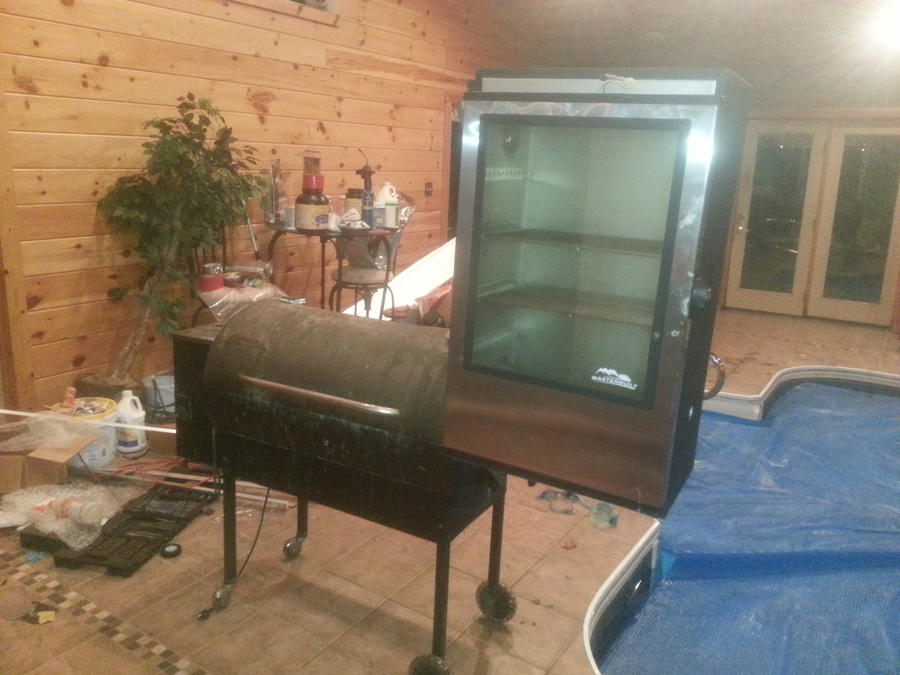Observations from a geek:
Test conditions:
MES 40 "windowless" second generation, model 20070613 available at Lowes for about $279.00 before discounts.
The unit has already been "smoked in" and used about 4 times since new.
Test temperature the unit is set for is 225 F.
Outside temperature is 78 F (early Arizona morning with cloud coverage).
It has the smaller chip tray, and chip loader from the factory.
No chips in tray, heating element only.
No liquids in water tray, wanting to see the unit's inherent temperature characteristics without other "stabilizing" factors (such as water or large hunks of meat).
Chip tray and loader fully inserted.
The "second probe" mention below is actually the built in meat probe, plus a chefmate remote probe both near the middle of the unit, set slightly left of center.
Both probes have been boil calibrated, and read within 2 degrees during calibration and this test event (once you allow for variations in display refresh rates).
The "button" sensor, which is read by the circuit board to determine when the heating unit is switched on and off is:
1. located on the same side, and near the heating element.
2. is bolted to the rear bulkhead.
Effects:
1a. on all heating cycles (except the initial heating cycle), it gets up to your set temperature faster than a second probe which is set on one of the middle racks. This results the heating element switching off before the second mid-rack probe reaching the "set temperature" by about 6 degrees.
2a. on the initial heating cycle, the thermal mass of the back bulkhead actually lowers the "button" sensor by several degrees (relative to the second probe), which causes an initial overshoot of temperature. I experienced about a 30 degree initial overshoot of internal temperature due to this characteristic.
Data:
Initial heat cycle, second probe temperatures hit 255, before the button probe registered 225 and switch off the heating element.
Temperature dipped to 189-192 on the second probe, before the temperature dipped below 225 on the button probe (bulkhead thermal mass), and switched on the heating element.
On subsequent cycles, the button sensor hit 225 (and switched off the heating element) when the second probes were at 216; with the element "off" it was still radiating heat and the second probes eventually reached 219. Statistical "average" second probe temperature observed, after two hours, was 205.5 degrees (against a set point of 225).
Geekspeak:
On the initial heating cycle, second probe temperature phase leads button probe significantly (due to bulkhead thermal mass, which is conducted into the button sensor).
On subsequent cycles, the proximity of the button probe to the heating element, and the heated bulkhead causes the temperature phase to lead the second probes "slightly".
Suggested engineering change:
Move the button sensor up about 10 inches (and center it from left to right), provide better thermal insulations from the bulkhead, so it reads actual free-air temperature more accurately.
Devil's advocate:
Exaggerated temperature swings encourage the heating element to stay on longer, which helps increase the peak temperature seen by the chip holder. This encourages more complete combustion of the chips. The large swings also allow for the chips to start smoking at a lower "set" temperature. The large temperature swings may very well be an intentional design feature.
For those who are using products like the
AMNPS, the large swings are not a benefit. The typical swing temperature seen, after the unit had been running over 2 hours, was roughly 27 to 30 degrees. In the grand scheme of things, not bad, but not great. Adding meat and water will improve the stability, but the high to low swing range will likely remain similar, as will the average cabinet free air temperature. More data is needed with a loaded cabinet to be sure.
 not sure what I am going to try first though. Maybe another pork roast, the last one tasted like the lit end of a cigar. I would like to redeem myself to the wife and kids
not sure what I am going to try first though. Maybe another pork roast, the last one tasted like the lit end of a cigar. I would like to redeem myself to the wife and kids








